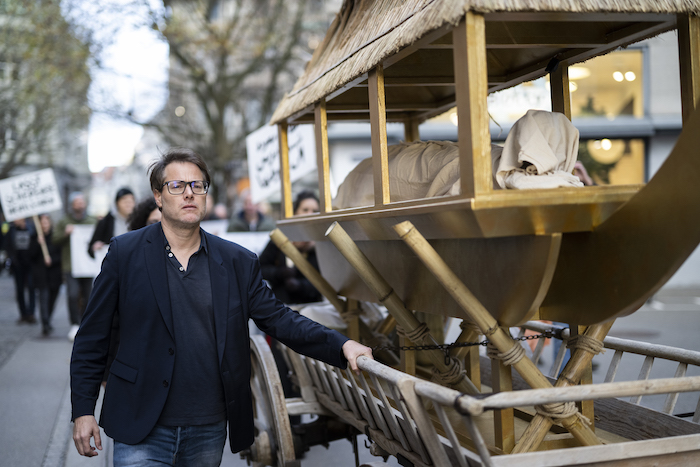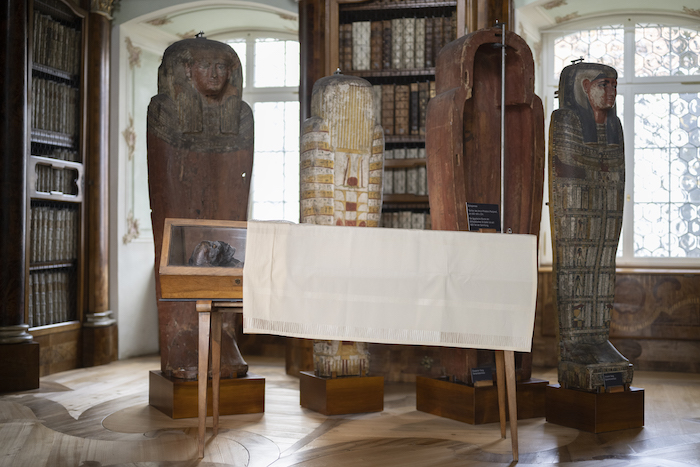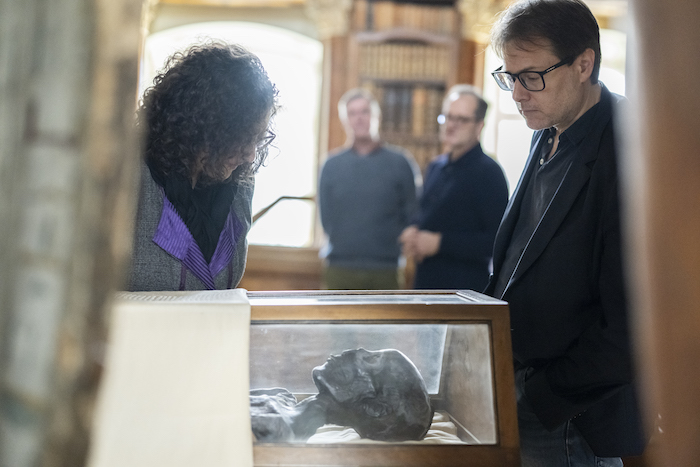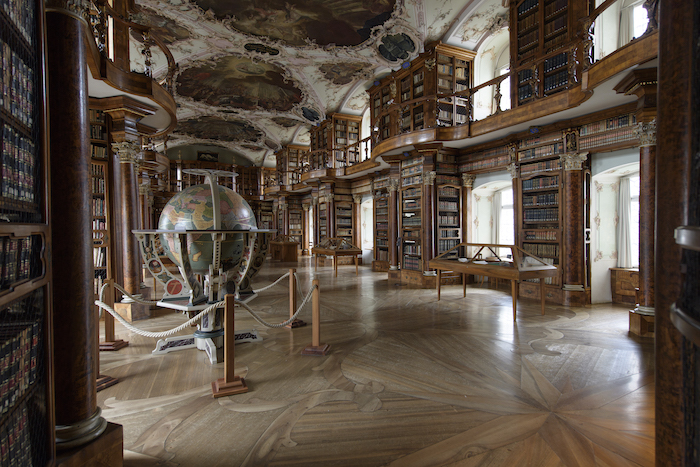الجمعة, مايو 19th 2023

An Egyptian mummy has been sitting in a Catholic abbey in Switzerland for more than 200 years without much dispute. But now people want to know how did the mummy get here? And more importantly, why should the mummy stay?
The story begins in one of the world’s oldest libraries, the St. Gallen’s Abbey Library, where a 2700-year-old Egyptian mummy resides. The mummy, Shep-en-Isis, is thought to be the daughter of an Egyptian priest who died in the 7th century B.C. around the age of 30. She has been on display in a glass coffin in the Abbey Library for more than 200 years.
The library of a baroque cathedral in the heart of Switzerland may seem like a strange resting place for a mummy, but the Abbey calls it the “most beautiful mausoleum imaginable.” The Abbey Library dates back to the 8th century and houses 160,000 priceless texts, including the oldest German bible. But it’s not the library’s historical significance or sumptuous decor that’s provoked recent debate, it’s the question of whether the library is the mummy’s rightful resting place that has proven difficult to answer.
Questions about her repatriation recently surfaced thanks to Swiss theater director Milo Rau. In November 2022, Rau won St. Gallen’s prestigious cultural award. In his acceptance speech, Rau announced that he would donate his CHF 30,000 prize to help return Shep-en-Isis to her original resting place in Egypt. The Shep-en-Isis exhibition is a “constant moral irritation,” lamented Rau.
“Presenting the mummy naked in the Abbey Library, next to the oldest German Bible, is a total absurdity,” he added.

In what he called a “ritual,” Rau created a mock-up of Shep-en-Isis in her coffin and wheeled it through the city of St Gallen flanked by other protestors. Along with the demonstration, Rau and his supporters launched the “St.Gallen Declaration for Shep-en-Isis: Let Shep-en-Isis Return Home.” Their declaration outlines legal and ethical reasons why Shep-en-Isis’s human remains should be returned to Egypt.
“It’s mostly spectacle and provocation,” the head of the Abbey Library, Cornel Dora, responded at the time. Rau is known to push boundaries and cover taboo topics such as terrorism and pedophilia on stage.
But the Catholic Administration Council, which owns all of the holdings in the Abbey Library, was also unmoved by his “artistic stunt.” The council emphasized that no voices in Egypt were actively reclaiming Shep-en-Isis.
Experts on the matter agreed. In a conversation with صندوق الائتمان SRF, Wiebke Ahrndt, ethnologist and President of the German Museum Association, said returning Shep-en-Isis didn’t make sense.
“The Egyptian side does not want [the mummy] either. That is why there is no reason on the European side to push it,” Ahrndt said.
This left observers wondering if Rau’s crusade was simply a publicity stunt. He openly admits to being an egotist. But by stripping back the dramatics and ignoring any questionable motives, Rau has a point. How we treat human remains and the provenance artifacts obtained is an important, if not complex, conversation.
Shep-en-Isis’s recent case represents a broader conversation globally and within Switzerland focused on rethinking ethnographic collections.

This changed three weeks after Rau’s announcement when an open letter addressed to the relevant parties was published. The letter, written by Monica Hanna, a professor at the College of Archeology and Cultural Heritage in Aswan, Egypt, demanded the restitution of the human remains of Shep-en-Isis back to Egypt. Signed by 200 scientists and Egyptologists, the letter claims that “Shep-en-Isis’s journey began with a grave robbery.”
Officials at the Abbey Library say that this version of events cannot be proven. The mummy was legally obtained and brought to Switzerland according to Egyptian law in the 1820s.
But Rau and his supporters say Shep-en-Isis’s existence in Switzerland marks an ongoing colonial injustice. At the time Switzerland obtained the mummy, Egypt had no real authority to control what happened to its cultural heritage.
In the eyes of Hanna, it’s ultimately less about legal questions than ethical ones. Simply because antiquities were legally purchased at the time does not mean they were ethically sourced.

Although experts are divided on Shep-en-Isis’s provenance, her case is an example of the broader conversation museums around the world are having about the ethics of their ethnographic collections.
Since the 1970 UNESCO convention, Swiss authorities have regularly returned illegally traded cultural objects. Today, the Federal Council provides Swiss museums with a budget of CHF 500,000 each year to conduct provenance research. While this sum could be called more symbolic than substantial, it’s a step in the right direction.
Historically, reparations and probes into provenance have mostly involved stolen Nazi gold and art from the Second World War. But Switzerland is also wrestling with how to restore cultural property derived from trade during the colonial era.
Benin Bronzes represent Switzerland’s recent efforts to decolonize collections and return objects to their rightful owners. But if the bronzes have shown anything, it’s that reparation is complex and with little precedence.
“[T]his process is painful as it poses awkward questions with regard to Swiss neutrality and Switzerland’s view of itself as a nation built on equality, solidarity, and humanitarianism,” says Joachim Sieber, who chairs the Swiss provenance research working group.

Shep-en-Isis’s case, as a partially unwrapped mummy, has not only prompted dialogue over the inequalities of the colonial trade but also posed questions about the ethics of displaying human remains in museums.
For many years, it was assumed in the ethical guidelines of the German Museums Association that after 125 years, human remains could be shown, even naked. However, this is no longer the case.
Sylvia Schoske, former director of the Egyptian Museum in Munich, writes that according to ancient Egyptian philosophy, “the exposure of an embalmed corpse is tantamount to its damnation.”
Ahrndt, who has written a guide on displaying human remains, adheres to the following principle: “The important task, and that is not an easy task, is that human dignity must be preserved. As exhibition organizers, we always have to ask ourselves the question: could I do the exhibition without the human remains?”

Supporters of Shep-en-Isis’s reparation urge that she should only be exhibited in her closed sarcophagus, or alternatively, a photo could be shown while Shep-en-Isis and her sarcophagi are kept in an appropriate place, such as the crypt of the monastery.
“We can exhibit mummies at our place if we can find a dignified way to do it. And as long as the same is done in the country of origin and people are not bothered by it,” Ahrndt advises, adding, “we living must care for the human dignity of the deceased.”
Raphael Kühne, President of the Catholic Administration Council, said they would “look seriously” into the possibility of returning Shep-en-Isis to her homeland in consultation with the Egyptian authorities. Kühne promises that whatever decision is made will be communicated to the public at an appropriate time.
“It is important to me that Shep-en-Isis is treated seriously and in a differentiated manner, also with reference to their country of origin,” Kühne said.
For now, Switzerland’s “most famous mummy” will remain in her baroque mausoleum, where the Abbey Library staff honor her with an end-of-day ritual. They cover the glass coffin with a white veil and speak words of respect for the Egyptian concept of eternal life over Shep-en-Isis.
يمكن مشاركة هذه المقالة وإعادة طباعتها مجاناً، شريطة أن تكون مرتبطة بشكل بارز بالمقالة الأصلية.
